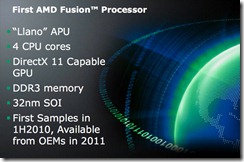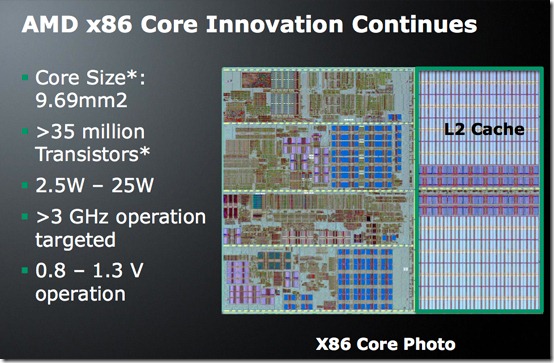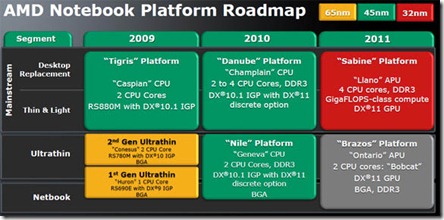 Intel may still be suffering the bad side of their so-called HD GPUs, but AMD is already ready to blow them away in Laptop market.
Intel may still be suffering the bad side of their so-called HD GPUs, but AMD is already ready to blow them away in Laptop market.
AMD has announced a new chip is called the “Llano” processor which is not just a CPU or GPU, instead, it’s a hybrid design that the chip company calls as an “Application Processor Unit,” or APU.
Intel’s current offering for the laptops is pretty limited in power they offer for graphics. They offer very-basic level of HD video playback, with DirectX 9 graphics to notebooks. AMD’s Llano will be combining a full DX11-compatible GPU with four CPU cores on a single 32nm processor die. This can literally swipe away all the Intel Laptop market.
At this time not much is known about the GPU, what we know is that the GPU offered by this APU combo is highly parallel vector. For the CPU, AMD has taken the “STARS” core that’s used in their current 45nm processor, shrunk them into a new 32nm SOI high-K process. AMD further added new power gating and dynamic power optimization capabilities to it. The result: 4Cores, each core has approx. 35 million transistors, and a 1MB L2 cache. It is planned to be clocked under 3Ghz and the power consumption would range between 2.5 to 25 watts(peek).
AMD will introduce another offering for the mobile called “Bobcat” which is more portable across a range of processes and configurations, and features less custom work that in Llano.
Llano will see some appearances in the later half of this year, and OEMs will be shipped around early 2011.
Power optimization
The most amazing part of this chip is it’s unique approach to dynamic power optimization. It is a step ahead from the traditional analog power management, towards digital, which makes it more accurate, efficient.
How Power optimization worked in current-gen. Processors: Normally, Power module takes analog input from a set of diodes placed throughout the die which act as thermal sensors, informing the module when the die heats up in an area due to increased compute activity.Temperature is the means for calculating power consumption.
Now, there is a problem with this approach: Ambient (surrounding) temperature changes (even minor ones) can change the values, make unwise decisions in setting the right clock speed and hence inefficient use of energy. And if the temperature changes are huge, like moving a laptop from A/C cabin to outdoors, the calculations go upto 40% incorrect.
However, Llano does it smartly. It uses a set of 95 bits of signals from different parts of the chip (pre-identified) are monitored, which have strong correlation to power consumption. This includes monitoring integer traffic, cache misses, or branch mis-predicts via low-frequency sampling, which yields a very-high accuracy in determining the power usage.
AMD Fusion and future:
Clearly, AMD + ATI Fusion is now the way to go on notebooks. The combo/Fusion will reduce the Bus latency between CPU-GPU as they are now on the same Chip, making graphics faster and GPGPU apps more powerful.
Intel barely has any integrated GPU for 2011. Unless Intel buys NVIDIA, I don’t see them leading this segment.
On the other side, NVIDIA’s upcoming x86 CPU + GPU combination would be interesting but we’ve to see how they perform in the CPU segment and not to forget they have some pending DMI licensing disputes.
Altogether, 2011 is going to be interesting for the notebook segment and It would make alot more sense even for general purpose apps to run on GPU with DxVA (DirectX Video Acceleration API) on Windows, VAAPI on Linux.
[via Inquirer]
We write Latest in Hardware: Intel, AMD, Research,Gadgets: Android, iPhone, Apple, Google and Tech Guides, Tech News @taranfx on Twitter and:
loading...
loading...


